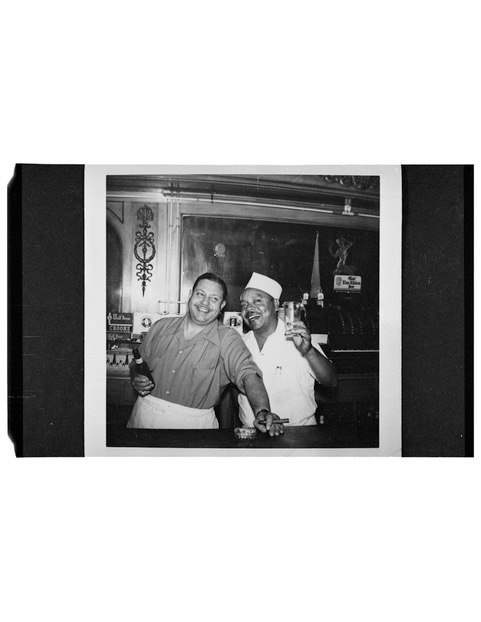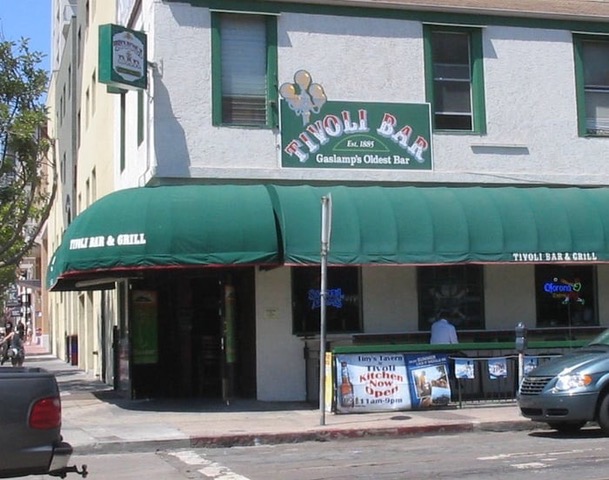Landmarks
Dive into the Tivoli!
Tivoli Bar and Grill
(1885)
Corner of 6th and Island Avenue
Architectural Style: Victorian Commercial
Architect: Unknown
When arriving in a downtown, thirsty travelers often ask where they can relax, become acclimated to their new surroundings and find a sociable atmosphere providing reasonably priced spirits. In other words – where is the local “watering hole” or dive bar. For over 138 years, the historic Tivoli (spelled backwards is “I lov it!”) has provided a friendly welcome for locals and visitors alike. The beer is ice cold, the hamburgers are hot, the ambience is warm and inviting, and the service – uninterrupted even during Prohibition- is quick and efficient. What’s not to like?
Like all old buildings in the Gaslamp, the Tivoli sits on land originally owned by Alonzo Horton. It was built in 1864 (before Horton) and called the Walker House. It was then a boarding house, a feed store, and a blacksmith shop. It was ultimately converted into a saloon and kitchen around 1885. The unimposing structure was basically a utilitarian building erected for commercial purposes. It had two windows, double-sashed, on each side. The first-floor windows now sport signature green awnings, and a sign proudly stating that the Tivoli is the oldest bar (still operating) in the Gaslamp. Structurally, nothing much has changed.
San Diego was growing rapidly during this period and the area surrounding the saloon became known as the Stingaree. Sailors making their way into the area from the port at the end of 5th said you could get quickly “stung” for your money by gamblers, ladies of the evening and other nefarious types. Much more dangerous than the little stinging fish in the bay! It was also not unusual to get “shanghaied” and find yourself at sea the next morning. This was
because of a tainted drink to knock you out, and a quick hustler to dump you off at a departing ship. All for a price, of course! Nonetheless, the saloon flourished.
The original bar, still a part of the current premises, was shipped around Cape Horn from Boston. This journey took between three and four months depending on the weather. The original cash register, acquired at the beginning of the 20th century, and the original safe, are located behind the bar. During a renovation in 1999, workers also discovered a button attached to a wire leading to the nine upstairs rooms, which served “working girls” and soldiers and sailors during the two World Wars. These rooms were rented by the hour, and patrons could be signaled when it was time to leave, or if they might be receiving a visit from the Vice Squad.
The saloon finally got its Tivoli name in 1915, when it was owned by two Italian families. It has been debated as to whether the name was in homage to the Tivoli Gardens in Rome, or the ancient town outside of Rome, a summer getaway for emperors and aristocrats.
During Prohibition (1920-19330, the Tivoli was converted into a “kitchen” supposedly serving food and non-alcoholic drinks. This was only on the surface, of course, as workers later found whiskey and wine bottles in the basement, where the alcoholic concoctions were made. It was rumored that they were passed up through a trap door under the pool table! They were one of the few drinking establishments that remained open throughout Prohibition.

Throughout the years, the Tivoli has been host to many well-known personages, none more famous than Wyatt Earp. Although the handsome Wyatt was listed in the San Diego City Directory as a “capitalist,” he is more well known as a lawman, a gambler and the instigator of the famous fight at the O.K. Coral in Tombstone, Arizona. Wyatt, not a drinker, knew where the action could be found, and he frequented the Tivoli often. His picture is featured on their wall.
The current owners, the Romero family, have been the proprietors since 1972. The parents passed the property over to the brothers –
Roy, Robert, Wilfred and Mike – when they retired. Mike, unfortunately, passed away in 2014. The family has decorated the walls with photos of not only Wyatt Earp, but also major league athletes, famous actors, friends, past employees, patrons, and previous owners. The Romero family patriarch, Spanish Lieutenant Juan Soza, is proudly honored. He was sent to the last Spanish garrison in the Southwest – Tuboc, Arizona. When he retired, Soza received a land grant in Tempe, which is now the home of Arizona State University. The Soza family also received a proclamation by the State of Arizona honoring them as the first European family to settle Arizona territory.
As a San Diego historically designated building, the Tivoli has the distinction of being a part of the city’s historical past and now a part of the vibrant Gaslamp and Petco Park scene. A favorite stop both before and after Padres games, the Tivoli still welcomes all who come to its doors with a smile and a cold beer. The more things change, the more it stays the same!
Sandee is the Historian/Lead Tour Guide for the Gaslamp Quarter Historical Foundation. She can be reached at [email protected].

